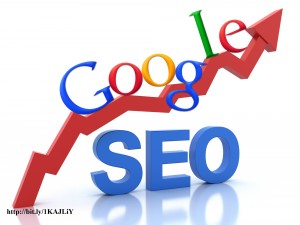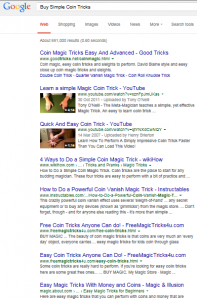A Guide to SEO for Small or Emerging Businesses
PART ONE: What is SEO and how can it be used to improve your digital marketing campaign?
What is SEO? Search Engine Optimisation (SEO) is essentially the process maximising where your website ranks in an internet search (Spais, 2010).
Popular internet search engines, such as Google, Yahoo, and Bing, store information on website content for every website available, and use ‘ranking algorithms’ to churn this information in to ‘search results’ which are ranked in terms of how ‘relevant’ the site it to your search (Beel, 2010). These search results are crucial to your business because the position your site is ranked will impact your visibility to customers (Newlands, 2014).
Try it right now, punch a few key words for your business into Google and see where your site ranks. First? Fifth? Eighth? Are you even on the first page of results? More importantly, where do your competitors rank? The higher your business rank’s, the easier it is for your customers to find you, and if people can’t find you, you’re losing access to that digital revenue stream.
So what can you do to fix it? Actually, the solution is pretty simple, and once you’ve learned to not-so-secret trick to improving your SEO, you’ll be wishing you’d applied it to your business sooner!
Here’s my two-part super-strategy for maximising the SEO for your business:
- Sign Up to Google Webmaster;
- Tailor you search terms;
Look simple? It is! You are two very short steps away from SEO perfection. Let’s explain these two initiatives…
First off, you don’t need to have a degree in SEO to know how to use it effectively, there are plenty of tools out there to make the whole process a lot simpler! One essential tool available to you is ‘Google Webmaster’ which essentially allows you to monitor searches to your site, assess the common flaws people make when searching for your site, and allows you to fix them (Seiter, 2014) . Take a look at this video on Google Webmaster:
Video URL: http://bit.ly/1rohOBZ
If you don’t already have a webmaster account, you can create one here: http://bit.ly/17WOXzv.
Webmaster is a fairly straightforward tool, and can certainly boost you SEO without you needing to be a data-wizard. That said, the more you learn about how to use Webmaster, the more you can tailor your digital marketing strategy to your particular business site and maximise your ROI. Google provide their own free online ‘Webmaster Academy’ which teaches you step-by-step how to master the tool, which you can access here: http://bit.ly/1eROn34.
Critique: Webmaster has had a somewhat antagonistic past, with criticisms that data provided by the tool was often inaccurate and insufficient (although, it is difficult to find any articles about this using a Google search – can you guess why?). Nevertheless, despite the flaws of the past few years, it would appear that all of these kinks have been removed, with the service functioning faster, better, and more efficiently than ever before (Cierniakoski, 2014).
Once you’re signed up to Google Webmaster, you will be able to see what search terms are used by your customers when trying to find your website, but it’s equally important for you to create some logical links of your own. Jayson Demers, CEO of Audience Bloom, stated that having little or no research on your search terms will render your SEO campaign a failure from the start (Demers, 2014). Therefore, it’s essential you do some preliminary groundwork if this initiative is going to help your business and not hinder it!
Demers went on to suggest a strategic approach to utilising key words in your SEO strategy – essentially, start by ascertaining which words link perfectly to you company,
This strategy would be better improved if you try to keep your search terms as specific to your business as possible, ie. your business specialises in hair products, but a generic search for “hair gel” will bring in floods of results, and it’s almost luck of the draw where your website will rank (short of posting the word “hair gel” hundreds of times on your landing page, there’s little you can do at this stage to boost your SEO – but do take a look at part two of this post for more advanced guidance once you’ve used each of these recommendation!). Therefore, specificity is key – what elements of your business set you apart from your competitors? How can you express this in words?
SPOTLIGHT ON THE FAST FOOD INDUSTRY: Whilst this branch of SEO doesn’t mean going crazy with your branding, when ascertaining your search terms it can sometimes be beneficial to delve into the heart of brand personalisation – this seems to have mostly succeeded in the fast food industry. One company that really took this to the next level is McDonalds, with virtually every product they sell starting with the prefix “Mc”, becoming so popular that simply adding “Mc” before the name of ANY food will make people instantly think it part of the company’s range (Patel, 2007).
Previously, it was really easy to identify these terms using Google Analytics, now however, that process has been restricted due to ‘Google encoding’, meaning you won’t be able to see some of your most popular search terms. And this process has taken a knock-on effect on Webmaster. Nevertheless, all is not lost, one thing Google can’t remove is your common sense! Think logically, and get in to the mind of your consumers – what would they put in to Google to find your business?
The easiest way to achieve this is by really looking into the content of your website – what is the heart of your business … the essence of your website?
So what are companies are getting this right?
Here are some practical examples using magic suppliers:
Say I’m trying to find a simple coin trick, and I search for just that:
The first ranking website under this search term is GoodTricks.net, and it’s not hard to see why, lets break this down:
The word ‘coin’ appears 28 times on their landing page, and the term ‘trick’ appears a further 27 times. This is the basis of this initiative in action – the more times the terms appear in the content of your site, the more likely that site is to be ranked higher by Google. Bear this in mind when dealing with your own search terms!
Top Tip: Don’t forget, Google uses synonyms! A search for ‘simple’ above, also revealed the word ‘easy’, in fact, the word ‘simple’ only appeared on the 10th link all other’s used ‘easy’. This is a key reminder that your vocabulary may not be the same a the aggregate vocabulary of your target market – but a simple Google search of these words will show you what the most popular terms are and these are the ones you should use the most!
So what businesses are getting it wrong?
Based on my own data analysis, Alakazam Magic UK is one of the top five businesses for selling coin tricks in the UK – and yet, they don’t appear at all on the first page of Google results. In fact, Alakazam rank 20th on a Google search, that’s the very last result on the second page! And even more shockingly, a study by Chitika, 2015, revealed that out of the 8 million Google users, only 6% will ever click on the next page of results! (Jensen, 2015). And even then, eye tracking studies indicate that viewers hardly pay any attention to that last link (Mendenhall, 2014). In other words, Alakazam can’t be selling many coin tricks unless customers actually embed the name ‘Alakazam’ in their search, handing over that revenue stream to their competitors, and entirely neglecting the potential to boost their ROI.
Top Tip: Once you’ve created and tailored your search terms , don’t be mistaken in thinking they are all you’ll ever need to use. Part of Google’s search service uses Google Bot to keep updated on all of your new pages and content. Basically, Google Bot (sometimes referred to as ‘Spider’) is a colossal internet trawling tool that scans the billions of websites logged on it’s registry lists every few seconds of every day. This means that every time you create a new branch of your website, Google Bot knows about it, and makes that page available via the main search engine. But you should do everything possible to maximise the publicity Google Bot gives your page by updating your search terms just as you’ve done above.
Congratulations! Now you know the secret first steps to boosting your website’s search engine ranking and visibility, why not step up you knowledge further and find out how to achieve near-perfect optimisation for your business by checking out PART TWO of this blog, due to be uploaded in a weeks’ time!
Thanks for reading! Do you have any tips to offer on how to improve SEO? Share your comments below!
Article by Kayleigh McChambell.
SOURCES
- Beel, Joeran, (2010), Academic Search Engine Optimisation: Optimizing Scholarly Literature for Google Scholar, Journal of Scholarly Publishing, Volume 41, Issue 2, page 176 – 190, page 176, paragraph 2;
- Cierniakoski, Ronald, (2014), In Defence of Webmaster Tools, Terqeet, available at: http://bit.ly/1dy6bGN;
- Demers, Jayson, (2014), 7 Advanced Ways to Improve Your Site’s SEO, Entrepreneur, available at: http://entm.ag/YGT9Pc;
- Jensen, Todd, (2015), Second Page Rankings, Gravitation Line, available at: http://bit.ly/1JcJQZa;
- Mendenhall, Ryan, (2012), You Image in Search Results – Google Authorship Markup, Rich Snippets, Mendenhall Creative, available at: http://bit.ly/1bHkhUZ;
- Newlands, Murray, (2014), Ranking Factors For Mobile SEO: Interview with Marcus Tober of Searchmetrics, Search Engine Journal, available at: http://bit.ly/1J8oMTk;
- Patel, Bina, (2007), McDonald’s Success Strategy and Global Expansion Through Customer Brand Loyalty, Journal of Business Case Studies, Volume 3, Issue 3, page 55;
- Seiter, Courtney, (2014), Five Simple Ways to Improve Your SEO Today, Buffer Social, available at: http://bit.ly/1zuZPlq;
- Spais, George, (2010), Search Engine Optimisation (SEO) as a Dynamic Online Promotion Technique: The Implications of Activity Theory For Promotion Managers, Innovative Marketing (Journal), Volume 6, Issue 1, page 6, paragraph 2;































Recent Comments